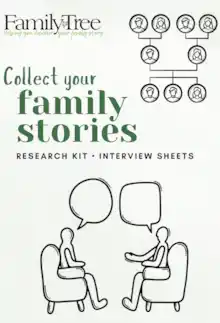06 October 2016
|
How can you get started with family history? Read this four-week, realistic family history research plan.
Family history is such a fascinating hobby and once you’re hooked there are so many interesting side lines to pursue that it’s all too easy to be led astray from the task in hand!
Learning how to do family history can be quite straightforward if you have a strategy to work to. To help you on your quest to ‘do’ your family tree, here is expert genealogist Mary Evan’s four-week family history research plan.
Week 1: Start creating a family tree
Begin by writing down what you already know, starting with yourself.
A simple tree with just names, dates and places is all you need at this stage. What supporting evidence do you have in the way of birth, marriage and death certificates? Make a note of any family stories you might have heard, but be aware that these are just stories and that you will probably have to verify their accuracy at some point.
One of your main early sources will be living relatives. Make a list of ones you need to talk to and decide how they could be contacted. A worksheet of questions is always worth spending time on, too, so that you don’t miss any vital bits of information. We have a selection of tree charts and interview sheets here. And don’t forget to sort out all those unnamed family photographs to take along with you too.
Week 2: Use certificates to grow your tree
Once you have all that basic information organised, the next step will be to expand what you know with birth, marriage and death certificates. Birth certificates will give you the names of parents including mother’s maiden name, while marriage certificates should give the names and occupations of fathers. Death certificates should give an age, possibly an address and the name and address of the informant.
Certificates for England and Wales can be ordered online here.
For Scotland, Northern Ireland and the Republic of Ireland see, respectively:
- www.scotlandspeople.gov.uk
- www.nidirect.gov.uk/articles/ordering-life-event-certificates
- www.hse.ie/eng/services/list/1/bdm/Certificates
Week 3: Expand your research horizons
In order to get further back you will next need access to birth, marriage and death indexes from 1837 onwards, census indexes, transcriptions and digitised images of records and parish register entries.
If you live in the same area as all your ancestors then you can probably use the local archives, but if not you can turn to one or more of the various websites that offer access to these resources. Now is the time to look carefully at these and decide which ones are going to be useful and might be worth subscribing to.
Look first, though, at some of the free websites:
FreeBMD has the post-1837 BMD indexes up until the mid-1970s and FreeCen has a great range of census indexes. FamilySearch has a huge range of worldwide records with the emphasis on parish registers.
And finally, Week 4: Build your family archive
The task for the fourth week is to decide how you are going to record and store all the information that you will accumulate once your research really takes off.
Old photos, newspaper cuttings, cards, certificates and the countless odds and ends of family memorabilia need to be stored in suitable conditions if they are to be preserved for years ahead. There is a range of storage solutions available so try an internet search on ‘archival storage’.
If you work on a computer then there are various family history programs available that will store all your data and also produce a range of family trees for you. As with websites, it’s important to do some research before deciding which program is right for your needs. See also our guide to Top free family history software.
Good basic organisation before you start will help you once you find yourself deep in the complexities of all the family lines that you are following – and all those interesting side lines too!









